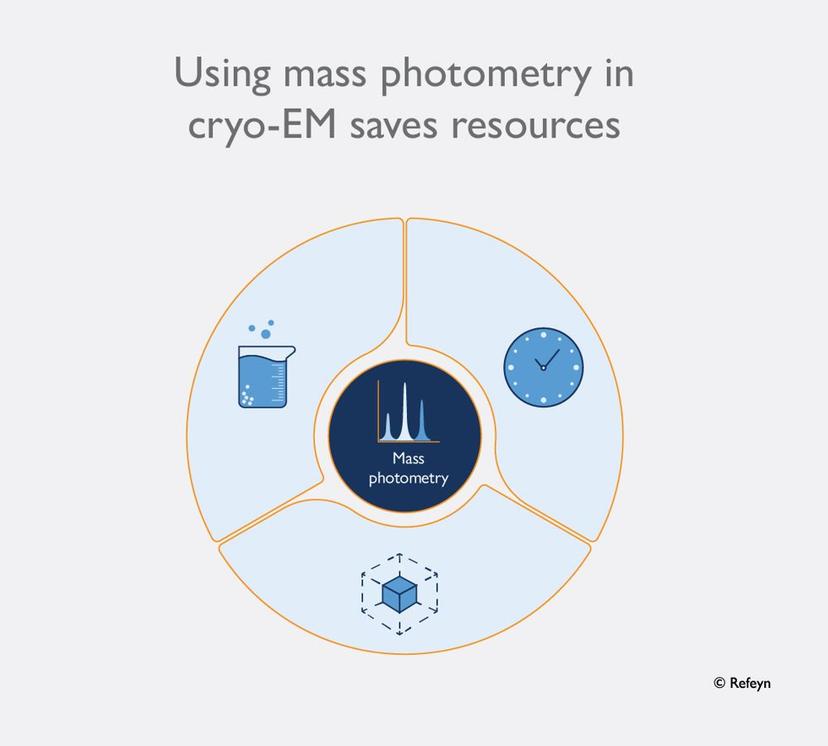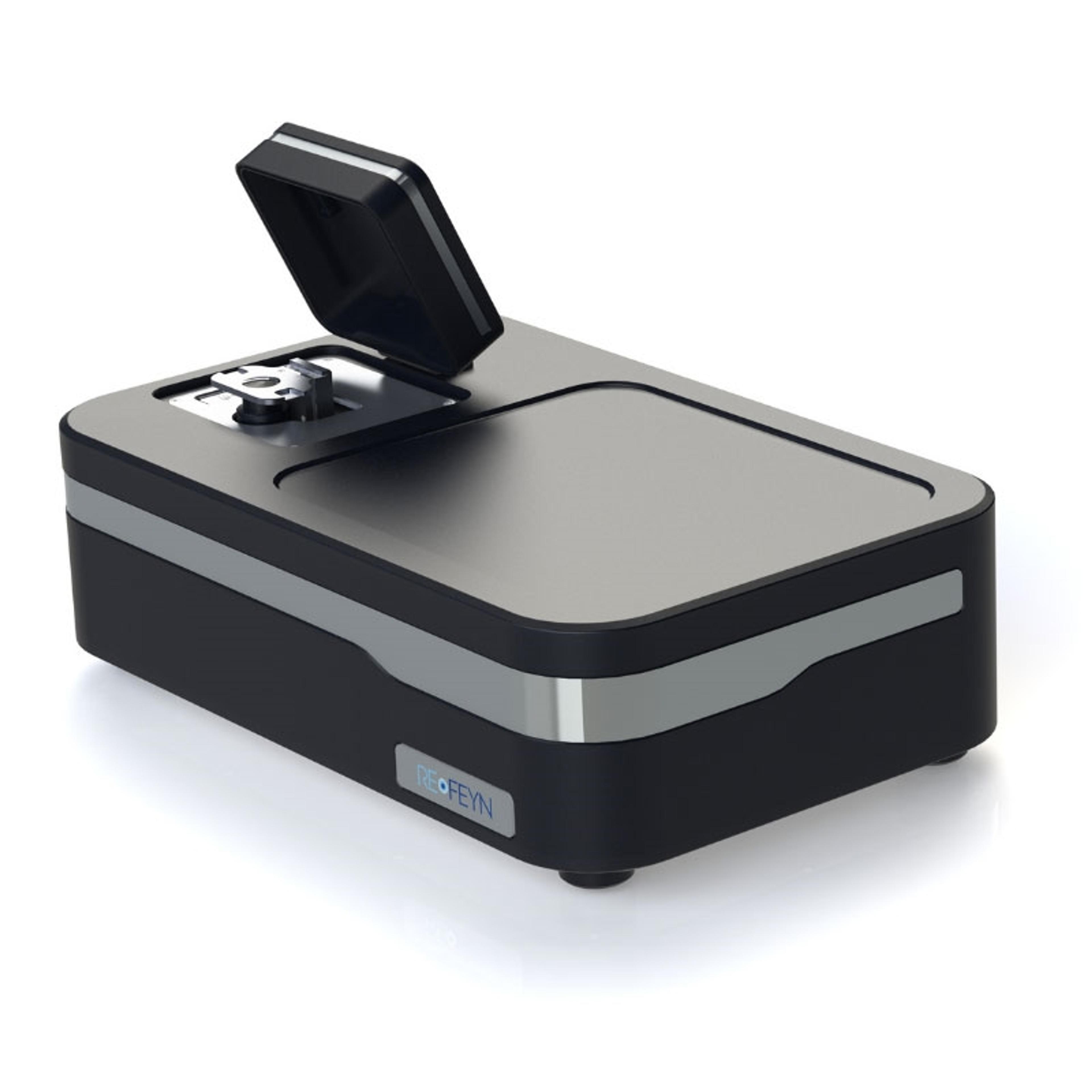Mass photometry saves you time and money in cryo-EM experiments
Mass photometry is an easy way to assess sample quality prior to cryo-EM analysis and is much faster than negative-stain EM
25 Aug 2022

You can never get enough time on an electron microscope. To make the most of the time you do have, you need to streamline the cryo-EM workflow. Negative stain EM (NS-EM) can help you optimize buffer conditions and assess sample quality before you move to the low-temperature microscope, but it’s a time-consuming, expensive technique. What you need is a cost-effective method that can speed up your analysis. The TwoMP, a bioanalytical tool that uses mass photometry to characterize biomolecules, can help you optimize your sample analysis without breaking the bank (or project budget). In this blog, Refeyn product manager Cathryn Langley, DPhil, tells us all about it.

Cathryn: “Over the last few years, mass photometry has started to enter more and more laboratories working within the structural biology space. This is a result of the recognition of the time- and cost-saving benefits to be had from utilizing mass photometry as a quick and experimentally straightforward method for screening sample quality prior to cryo-EM analysis. The technique requires minimal sample and can measure biomolecules in their native state, with its single-molecule resolution over a wide dynamic range making it ideally suited for assessing sample monodispersity.
Below, the most common questions about the benefits of using the TwoMP, the sample requirements, and about the instrument itself are addressed.
How can the TwoMP help with cryo-EM sample optimization?
The TwoMP mass photometer can help you determine sample purity and measure the percentage of a sample population that has formed the desired complex before you proceed with cryo-EM. Collecting these data is an important step in sample quality control that can help you improve structural resolution and data reproducibility. You can also use the TwoMP to optimize buffer conditions to promote the complex formation, as recently summarized in 1 and 2. The instrument is compatible with detergents, so you can keep membrane proteins and lipid nanodiscs – as well as biomolecules that are soluble in aqueous media – in solution during analysis. That way, you can keep proteins in their native states, or as close to them as possible.
How does mass photometry compare to other biomolecular characterization techniques?
Data from the TwoMP has been shown to agree well with data from negative stain EM, charge detection mass spectrometry (CD-MS), and native MS, as described in 2-4. The advantage of mass photometry over these techniques is that it is much faster and simpler to use.
In contrast to light-scattering techniques, like dynamic light scattering (DLS) or multi-angle light scattering (MALS), mass photometry is a single-particle technique. This means that it counts how many particles in your sample have a particular mass. Coupled with its wide dynamic range and wide mass range, this makes mass photometry more sensitive to the detection of low abundance species, such as aggregates and provides access to sub-populations within samples.
You say it’s faster than negative stain EM – how long does a TwoMP measurement take?
Each measurement with the TwoMP only takes one minute! As a TwoMP user from a structural biology lab told us, “Typically, I can check the sample in one minute by mass photometry, whereas my negative stain would probably have taken a couple of hours.” The TwoMP really can save you hours in the optimization phase of your experiments.5
How expensive is using the TwoMP, compared to negative stain EM?
We all know that cryo-EM and negative stain EM are expensive techniques. The costs to prepare and run a negative-stain sample grid at an electron microscopy center (such as this one at the University of Wisconsin) can easily add up to over $100 per hour. In comparison, the consumables needed for each mass photometry measurement cost less than $5, based on our calculation. Since the instrument is so easy to use, it does not require a highly trained operator, which contributes to savings as well. Overall, the TwoMP is certainly a cost-effective analytical tool.

About the TwoMP instrument
Does the TwoMP need a special environment to operate, like an electron microscope?
The TwoMP is a low-footprint instrument that fits on a benchtop. It does not need its own dedicated room, unlike an electron microscope. The TwoMP comes with its own anti-vibration device, and the entire setup fits neatly into your existing lab without additional construction.
What is the mass range for the TwoMP?
The TwoMP can measure masses from 30 kDa to 5 MDa.
About the sample
Do I need to use heavy metal staining or label my samples for mass photometry?
Mass photometry is a label-free technique that measures the mass of biomolecules in their native state, so you can use whatever buffer conditions are appropriate for your cryo-EM sample. There is no need for the hazardous heavy metals used in negative stain EM or for drying out your sample, which can introduce artifacts into your data and make it more difficult to optimize buffer conditions later for cryo-EM.
How much sample do I need for a mass photometry measurement?
Mass photometry measurements require very little sample – about 10-20 µL. The optimum sample concentration is typically at the low nanomolar level. You will have plenty of sample left over to use for cryo-EM after a mass photometry experiment.
Want the latest science news straight to your inbox? Become a SelectScience member for free today>>
References:
S. Niebling et al., “Biophysical Screening Pipeline for Cryo-EM Grid Preparation of Membrane Proteins,” Frontiers in Molecular Biosciences, vol. 9, p. 535, Jun. 2022, https://doi.org/10.3389/fmolb.2022.882288
A. Sonn-Segev et al., “Quantifying the heterogeneity of macromolecular machines by mass photometry,” Nature Communications, vol. 11, no. 1, pp. 1–10, Dec. 2020, https://doi.org/10.1038/s41467-020-15642-w
V. Yin et al., “Probing Affinity, Avidity, Anticooperativity, and Competition in Antibody and Receptor Binding to the SARS-CoV-2 Spike by Single Particle Mass Analyses,” ACS Central Science, vol. 7, no. 11, pp. 1863–1873, Nov. 2021, https://doi.org/10.1021/acscentsci.1c00804
M. A. den Boer, S.-H. Lai, X. Xue, M. D. van Kampen, B. Bleijlevens, and A. J. R. Heck, “Comparative Analysis of Antibodies and Heavily Glycosylated Macromolecular Immune Complexes by Size-Exclusion Chromatography Multi-Angle Light Scattering, Native Charge Detection Mass Spectrometry, and Mass Photometry,” Analytical Chemistry, vol. 94, no. 2, pp. 892–900, Dec. 2021, https://doi.org/ 10.1021/acs.analchem.1c03656
Y. Xu and S. Dang, “Recent Technical Advances in Sample Preparation for Single-Particle Cryo-EM,” Frontiers in Molecular Biosciences, vol. 9, p. 892459, Jun. 2022, https://doi.org/10.3389/fmolb.2022.892459

